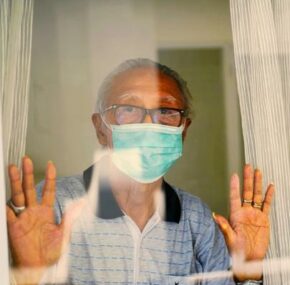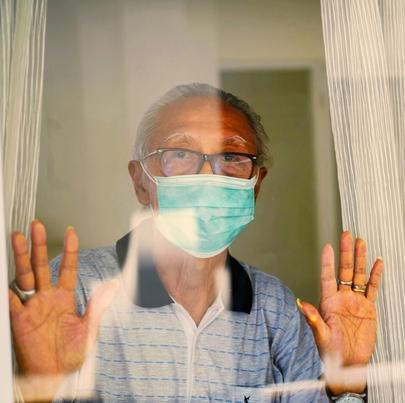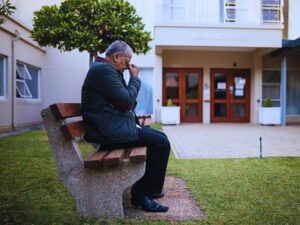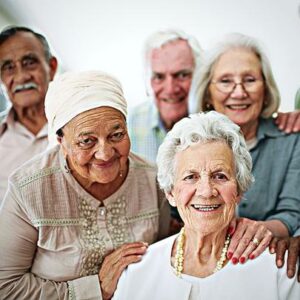With COVID-19 mandates in place that limit nursing home visitors during the pandemic, residents are facing a silent health threat for the holidays – social isolation.

Nursing Home Residents Facing Isolation
The Coronavirus pandemic has taken a serious toll on nursing homes around the country. Since the beginning of the pandemic in 2019, private nursing homes and long-term care facilities have been hit with high rates of COVID-19 illnesses and deaths. In close quarters where many residents are confined to beds and wheelchairs, nursing homes have faced an uphill battle to keep residents safe and healthy.
The Coronavirus outbreak has caused infections, severe illnesses, and fatalities for millions of Americans, but the hardest-hit age group has been elderly adults living in nursing homes and long-term care facilities. Due to underlying health conditions and weakened immune systems, elderly adults are in a high-risk group for COVID-19 deaths. In 2020, the Centers for Disease Control and Prevention (CDC) reported 282,000 cases of Coronavirus in U.S. nursing homes, accounting for 43% of total COVID-19 deaths. Many of these deaths resulted in negligence lawsuits with nursing home lawyers.
At the height of the pandemic in 2020, the Trump administration banned all visitors to nursing homes and long-term care facilities. Shortly after, nursing home COVID regulations and mandates were turned over to the discretion of individual states. While some states granted outdoor visits with family members and friends, other states prohibited all visitors. In September 2020, the Centers for Medicare and Medicaid Services (CMS) issued new COVID guidelines for nursing homes. Outdoor visits were encouraged due to a lower rate of transmission, and indoor visits were allowed in facilities with no COVID cases for at least 14 days.
2021 has seen a significant decline in nursing home deaths due to COVID vaccines and strict facility regulations, but problems for residents are now taking a different turn. While COVID illnesses and deaths have declined, COVID mandates and regulations have nursing home residents fighting health problems caused by social isolation.
The Impact of Social Isolation
Social isolation is defined as an objective state of having infrequent social contact or few social relationships with other people. It is also defined as a significant risk factor for loneliness. Both conditions are extremely common in nursing homes and long-term care facilities where most residents are over the age of 65. The prevalence of severe social isolation and loneliness among older people living in nursing homes is at least double that of community-dwelling populations. According to research studies, more than half of nursing home residents without cognitive impairments report feeling lonely most of the time.
Social isolation and the basic need for meaningful relationships with family members and friends play critical roles in feelings of loneliness. Social isolation and loneliness are commonly associated with increased physical illnesses and mental health risks, including.
- Obesity
- Elevated blood pressure
- Recurrent strokes and heart attacks
- Progression of cognitive decline and Alzheimer’s
- Anxiety and/or depression
- Suicidal thoughts
Social isolation and loneliness are often related to the absence of a significant person such as a partner or spouse who provides companionship and emotional support. For some people, that important role may be fulfilled by friends, family members such as siblings, children, grandchildren, or even a family pet.
According to the National Institute on Aging (NIA), social isolation significantly increases a person’s risk of premature death. The risks rival those of smoking, obesity, a sedentary lifestyle, and cognitive impairments. Research shows that social isolation is associated with at least a 50 percent increased risk of dementia and Alzheimer’s disease, a common problem linked to cases of neglect and abuse handled by Chicago nursing home lawyers. For some nursing home residents, prolonged isolation can prove deadly. Reports from multiple nursing home facilities show that residents became severely depressed and stopped eating after facilities banned family visitation during COVID lockdowns.
Throughout the pandemic, most nursing homes have made substantial efforts to keep residents socially engaged while following COVID regulations. With decreased staff, many facilities have established family video chats and phone calls and coordinated family visits between residents and visitors. Some facilities have even coordinated parades, live music concerts, and therapeutic pet drop-in sessions through windows. Rehabilitation departments are taking residents outdoors for physical and occupational therapy, so they get fresh air and sunshine to stimulate mood and health.
Since indoor visitation is still limited, some nursing homes are using closed-circuit television systems to broadcast activities to residents in their rooms. Some facilities permit residents wearing masks to sit in their doorways so they can talk to other residents across the hall. Although distanced visitation does help with social isolation, it does not take the place of hand-holding, a hug, or a kiss. The impact of social isolation and loneliness is still a major concern in nursing homes.







